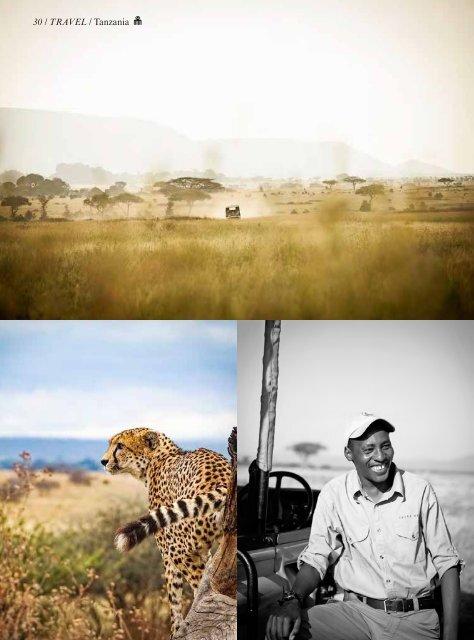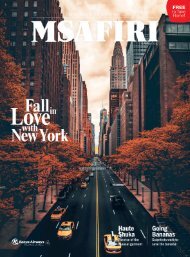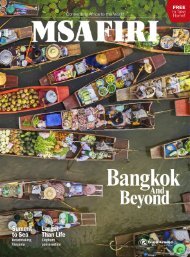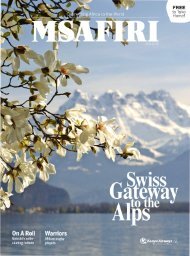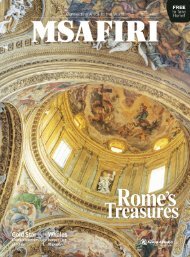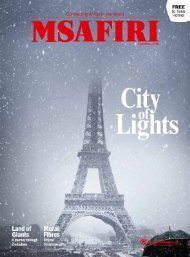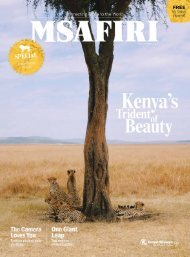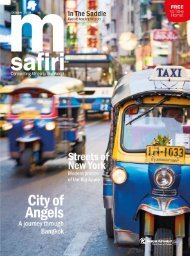Create successful ePaper yourself
Turn your PDF publications into a flip-book with our unique Google optimized e-Paper software.
30 / TRAVEL / Tanzania<br />
TRAVEL / 31<br />
Left page: Searching for<br />
the Big Five (top); Cheetah<br />
at Tarangire National<br />
Park (bottom left); Ranger<br />
at Katavi National Park<br />
(bottom right)<br />
Left: Nomad<br />
Tanzania’s Kigelia<br />
Ruaha, Ruaha<br />
National Park<br />
Right: Chada Katavi,<br />
Katavi National Park<br />
Eliza Powell<br />
“The simplicity of the lodge’s unfussy<br />
interior is a comforting reminder of the game-park<br />
destinations of my childhood”<br />
Eliza Powell (top and bottom right), Brenden Simonson (bottom left)<br />
The baobab is mute now, silent roots waving in protest as<br />
elephants rub up against it or rest in its shade. It’s said that a<br />
baobab becomes handsome once it’s 1,000 years old, which<br />
puts the majestic trees of Tarangire at a very grand age.<br />
On day two, I head deeper into the park where the blonde<br />
grasses of the drier northern tip give way to longer, greener<br />
grass. Here, warthogs’ antenna-like tails poke above the grass,<br />
providing the only indication of their position. Later, I head<br />
towards the damp interior, which is dominated by the sprawl<br />
of the Silale, Lormakau and Ngusero Oloirobi swamps. Here<br />
you’ll find Nomad Tanzania’s Kuro Tarangire tucked into acacia<br />
woodland, hidden in a shallow valley on the banks of the<br />
Tarangire River. The camp’s proximity to the Silale means<br />
that game gathers here in the dry season to graze, while<br />
elephants dig for water in the riverbed. The camp is only two<br />
years old, and it has just six tents, but they’re enormous and<br />
have huge decked verandas, internal and external showers, and<br />
acres of bed swathed in snow-white mosquito nets.<br />
ALL RIGHT ON THE NIGHT<br />
Night drives and bush walks offer an extraordinary<br />
opportunity to get up close and personal with the bush. Night<br />
drives give insight into the lives of nocturnal animals that<br />
remain well hidden during the day, such as the small genet<br />
and serval cats. Bush walks immerse you in the wilderness,<br />
literally. Before coming here, I was advised to use well-reputed,<br />
responsible organisations where I’d be accompanied by<br />
the best guides, making my experience spectacular and safe.<br />
I follow that advice and take a night drive with guide Rajabu<br />
and spotter Maripe, who has the keenest eyes in the country,<br />
according to Rajabu. Even though it’s dark and we’re in a<br />
moving vehicle, Maripet soon spots a chameleon. Night drives<br />
lend a quite different safari experience, accompanied by an<br />
orchestra of distinctive sounds: the hiss of daytime cicadas<br />
and chattering vervets is replaced with the clicks and calls of<br />
nightjars and bush babies. The whoop-whoop of a hyena fills<br />
the air when Rajabu turns the car’s ignition off in order for us<br />
to watch that chameleon move in slow motion along a branch.<br />
Night drives remain mercifully exclusive in Tanzania because<br />
the Tanzania National Parks Authority has only issued<br />
permission to a few select operators. Long may it stay that<br />
way. A night drive in Zambia’s South Luangwa National Park<br />
used to be a miserable procession of brake lights as cars<br />
moved slowly, nose-to-tail, while dozens of spotlights swept<br />
the bush scaring away game. ><br />
Other National Parks<br />
with Big Game<br />
Katavi National Park lies in the west of Tanzania. At<br />
almost 4,500 sq km it’s the country’s third-largest<br />
National Park, after the Serengeti and Ruaha. The<br />
Katisunga Plains, a vast 400 sq km, account for 10<br />
percent of the park, and are captured by the Ufipa<br />
escarpment part of the Great Rift Valley. In dry west<br />
Tanzania, Katavi offers fabulous wild game viewing<br />
opportunities and the greatest concentration of<br />
hippos in Africa.<br />
Ruaha National Park is Tanzania’s second-largest<br />
national park. Named Saba Game Reserve in 1910,<br />
the park became the Rungwa in 1946, and 30 years<br />
later, it was renamed the Ruaha, after the Great<br />
Ruaha River, which forms its eastern boundary. Other<br />
arteries that sustain the park and its wildlife are the<br />
Jongomero, the Mdonya and the Mwagusi. The park<br />
is over 20,000 sq km: a vast sprawling space with big<br />
game and long views.<br />
Where to Stay<br />
Ikuka Safari Camp<br />
Providing amazing views over Ruaha National Park<br />
and its mighty baobab tree, hills and wildlife, this<br />
camp has six tents equipped with all-day electricity,<br />
hot water and super-king beds. ikukasafaricamp.com<br />
Kigelia Ruaha<br />
A simple tented bushcamp located in the Kigelia<br />
(sausage tree) grove, which offers all the comforts you<br />
need for a memorable safari.<br />
nomad-tanzania.com/south/kigelia-ruaha<br />
Ruaha River Lodge<br />
Set on one of the most beautiful stretches of the<br />
Great Ruaha River, you can see game throughout<br />
the day from the comfort of your veranda.<br />
ruahariverlodge.com


